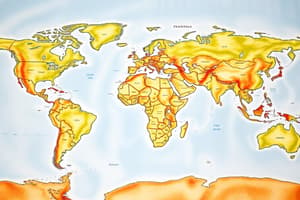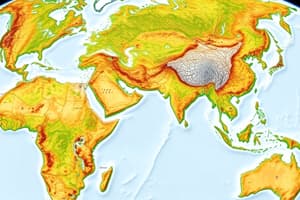Podcast
Questions and Answers
What is the primary characteristic of seasons?
What is the primary characteristic of seasons?
- Unique ocean conditions
- Unique planet conditions
- Unique climate conditions (correct)
- Unique time periods
How do seasons affect vegetation and plant growth?
How do seasons affect vegetation and plant growth?
- They have a significant impact (correct)
- They only affect vegetation
- They only affect plant growth
- They have no effect
What is the main reason for the seasons on Earth?
What is the main reason for the seasons on Earth?
- The Earth's orbital plane
- Earth's tilted axis (correct)
- The distance between the Earth and the Sun
- The speed of the Earth's rotation
What is typical of mid-latitudes?
What is typical of mid-latitudes?
When is winter in the Northern Hemisphere?
When is winter in the Northern Hemisphere?
What happens near the Equator?
What happens near the Equator?
What is the longest day of the year in the Northern Hemisphere?
What is the longest day of the year in the Northern Hemisphere?
What is the characteristic of winter?
What is the characteristic of winter?
What happens in pole regions?
What happens in pole regions?
In which hemisphere does winter begin in June?
In which hemisphere does winter begin in June?
What is the imaginary line that runs through the center of the Earth?
What is the imaginary line that runs through the center of the Earth?
How many seasons are there in a typical year?
How many seasons are there in a typical year?
Why does the Northern Hemisphere receive more daylight in June?
Why does the Northern Hemisphere receive more daylight in June?
What is responsible for the occurrence of seasons?
What is responsible for the occurrence of seasons?
What happens to the Northern Hemisphere in December?
What happens to the Northern Hemisphere in December?
What is the opposite of winter in the Northern Hemisphere?
What is the opposite of winter in the Northern Hemisphere?
What is typical only in the mid-latitudes?
What is typical only in the mid-latitudes?
What marks the beginning of spring in the Northern Hemisphere and autumn in the Southern Hemisphere?
What marks the beginning of spring in the Northern Hemisphere and autumn in the Southern Hemisphere?
How many hours of daylight does Helsinki, Finland, see in mid-June?
How many hours of daylight does Helsinki, Finland, see in mid-June?
What is characteristic of Athens, Greece, in southern Europe?
What is characteristic of Athens, Greece, in southern Europe?
When does the Northern Hemisphere receive the most direct sunlight?
When does the Northern Hemisphere receive the most direct sunlight?
What is true about places near the Equator?
What is true about places near the Equator?
What is the result of the Northern Hemisphere being tilted away from the Sun?
What is the result of the Northern Hemisphere being tilted away from the Sun?
When do both hemispheres receive equal amounts of daylight and darkness?
When do both hemispheres receive equal amounts of daylight and darkness?
What is characteristic of the polar regions?
What is characteristic of the polar regions?
What marks the beginning of winter in the Northern Hemisphere and summer in the Southern Hemisphere?
What marks the beginning of winter in the Northern Hemisphere and summer in the Southern Hemisphere?
What happens in Barrow, Alaska, between mid-May and early August?
What happens in Barrow, Alaska, between mid-May and early August?
What causes different parts of the Earth to receive varying amounts of sunlight?
What causes different parts of the Earth to receive varying amounts of sunlight?
When is the Northern Hemisphere tilted toward the Sun?
When is the Northern Hemisphere tilted toward the Sun?
What happens around March 21st?
What happens around March 21st?
Study Notes
Seasons
- Seasons are distinct periods of the year with unique climate conditions, with four seasons being spring, summer, autumn, and winter.
- Seasons significantly influence vegetation and plant growth, with winter having cold weather, limited daylight, and limited plant growth.
- The four-season year is typical only in mid-latitudes, with larger differences in seasons farther north.
- Near the Equator, regions experience little seasonal variation, while pole regions experience significant seasonal variation, with daylight changes dramatically between summer and winter.
How Seasons Occur
- Earth's tilted axis causes the seasons.
- Throughout the year, different parts of Earth receive the Sun's most direct rays.
- When the North Pole tilts toward the Sun, it's summer in the Northern Hemisphere. When the South Pole tilts toward the Sun, it's winter in the Northern Hemisphere.
Characteristics of Seasons
- In the Northern Hemisphere, winter generally begins on December 21 or 22, and summer begins on June 20 or 21.
- Spring and autumn begin on equinoxes, days that have equal amounts of daylight and darkness.
- The vernal, or spring, equinox falls on March 20 or 21, and the autumnal equinox is on September 22 or 23.
- The seasons in the Northern Hemisphere are the opposite of those in the Southern Hemisphere.
Earth's Axis and Orbit
- Earth's axis is an invisible line that runs through its center, from pole to pole, and it is tilted relative to the orbital plane.
- Earth rotates around its axis, which is tilted at an angle of about 23.5 degrees.
Variations in Sunlight
- Because of the axial tilt, different parts of the Earth receive varying amounts of sunlight throughout the year.
- When a hemisphere is tilted toward the Sun, it experiences summer. When it is tilted away, it experiences winter.
- The intermediate stages are spring and autumn.
Seasonal Variations by Region
- The four-season year is typical only in mid-latitudes.
- Places near the Equator experience little seasonal variation, with alternating rainy and dry seasons.
- Polar regions experience significant seasonal variation, with daylight changes dramatically between summer and winter.
Studying That Suits You
Use AI to generate personalized quizzes and flashcards to suit your learning preferences.
Description
Test your knowledge of geography principles, covering topics such as seasons and more. This quiz is based on the course BSSI11033, Year I and Semester I of the BA (Hons) in Social Studies in Indigenous Knowledge.




